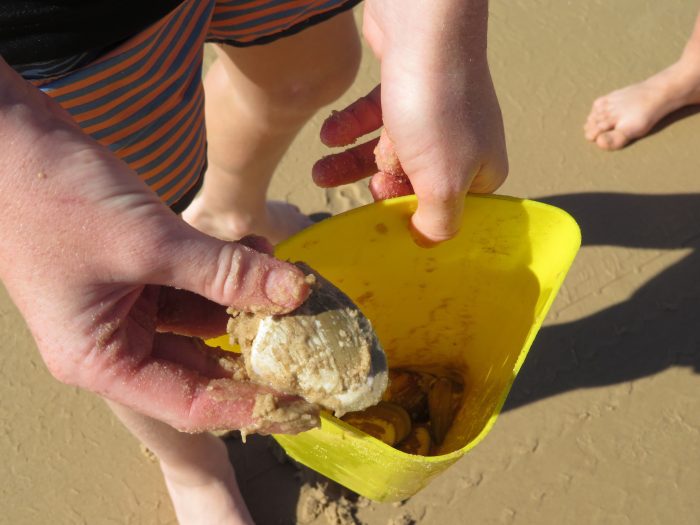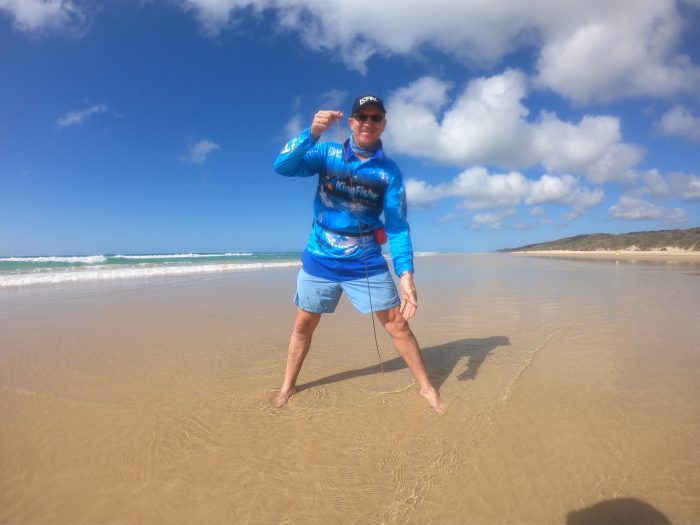AS we enter the final month of winter, the beach fishing season in Queensland and Northern NSW is seriously heating up. So too are the shallow estuary flats, particularly as we head towards the full moon in August and into spring. When it comes to light line bait fishing from the beaches or flats, fresh live bait is best. Let’s have a look at three of the best live bait types for the beach and estuary flats. bait beach flats
Pipis
I’ll start with pipis, which are third in my top three list for light line live bait species. However, it’s important to point out that pipis are best used solely from the beach and not the estuary flats. This is because they are not a natural bait from calm estuary waters.
Pipis can be collected two main ways. First, from long open beaches which permit four-wheel-drive access. On these beaches, pipis can be easily spotted in the intertidal zone by looking for small raised mounds under 4WD tracks in the sand. This is a dead giveaway that a pipi lies underneath. Use your fingers or a blunt instrument – not a knife – to extract the pipis from the sand. They will be only a few centimetres under the sand.bait beach flats

On beaches where 4WDs are not permitted, pipis can be found by doing the ‘pipi shuffle’. This is a matter of simply shuffling your feet into the sand as the water covers your feet or ankles until such time as you feel pipis beneath your feet. When you find one, shuffle around in the immediate area because they tend to be found in batches. The hour either side of low tide is best.

Yabbies
Second on my favourite light line bait list are yabbies. Now unlike pipis, these are found on the western or calm side of the island and so are best used in those locations. They can at a pinch be kept alive and used off the beach, though again they are better used in areas they are found naturally. Yabbies are easy to find by looking for small holes in the sand in the intertidal zone and the edges of mangroves.bait beach flats
They are best pumped in those areas of slightly darker sand interspersed with small melon holes. And look for evidence of disturbed sand around the hole as evidence of a yabby ‘in residence’. Likewise, areas of soft sand rather than mud close to mangroves are good spots. It’s then a matter of using a yabby pump and pumping two or three times over the holes to find them.

When you hear the ‘slurping’ sound of soft sand and water as you pump, you are usually in the ideal yabby zone. Yabbies can also be pumped at high tide into a sieve held by a friend or attached to your body by a rope and a piece of pool noodle wrapped around the sieve to make it float. Finally, if you are choosing a pump for the first time, unless you are purchasing one for your kids to use, go for the longer king-size pumps because these are easier on your back bending over to pump.bait beach flats
Worms
Finally, and number one on my bait list for the beach and estuary flats are live worms. Off the beach, I find it’s hard to beat a piece of fresh live beachworm for thumping big whiting, bream, tarwhine, flathead or even pesky dart. Beachworms also work well at the entrances to estuaries and the western side of Queensland’s big sand islands.
Beachworms can be caught on most stages of the tide but are easiest to extract in the last two hours before and the first hour after a low tide. Look for areas of flat beach near the water line where a very thin layer of water washes back and forward over the sand. You then want to work your ‘stink’ or keeper bag full of fish frames from the top of where the water is reaching to the edge of the water.bait beach flats

Then look for heads sticking up or ‘V’s as the water washes back – a giveaway of a worm head. You want to use a firm finger bait such as a pipi or a firm piece of fish flesh for the worm to grab while you work your fingers into the sand to pinch it firmly and lift. There’s plenty more to this little trick, which is best explained via the videos available on my Facebook page.
However, as you get further away from the estuary mouth and up the creeks, blood or mangrove worms take over as the No. 1 bait. Much harder work, these can be extracted by either digging with your hands in the thick mud near mangroves or using a pitchfork along muddy and weedy bay foreshores. So, there you go. I hope these tips help you score quality fresh bait to improve your catch on your next beach or estuary flats trip.bait beach flats
For more tips and reports, jump onto my Facebook, Instagram and Youtube pages – Ontour Fishing Australia.
 Bush 'n Beach Fishing Magazine Location reports & tips for fishing, boating, camping, kayaking, 4WDing in Queensland and Northern NSW
Bush 'n Beach Fishing Magazine Location reports & tips for fishing, boating, camping, kayaking, 4WDing in Queensland and Northern NSW








